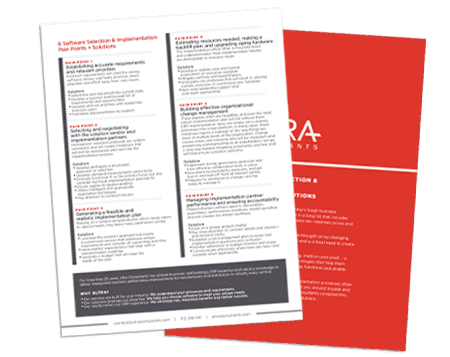Enterprise Resource Planning (ERP) software is a powerful tool that can enhance the efficiency of your organization’s operations. It can help streamline your business processes, improve communication and boost productivity. However, implementing an ERP system can be a complex and challenging process. Without a successful software implementation plan, it can lead to delays, cost overruns and even failure of the software implementation project. Therefore, it’s important to have well-thought-out software implementation plan steps to ensure a successful implementation.
This article will cover the following:- Steps in a Software Implementation
- Best Practices for Software Implementation
- Common Software Implementation Challenges and How to Overcome Them

6 Software Selection & Implementation Pain Points + Solutions
Today’s business environment is tough and volatile! Our downloadable PDF will help you see Pain Points + Solutions!

Steps in ERP Software Implementation
Step 1 — Create a Project Team
A successful software implementation process plan requires a dedicated team to oversee the software implementation process from start to finish. The implementation team reflects the entire company and should include representatives from all areas that will be affected by the new software system, such as IT, finance, operations and HR. The team should be led by a project manager who has experience developing software implementation plans, setting goals and timelines, creating the business case, identifying potential risks and obstacles and assigning specific tasks to team members.
In addition, the implementation team should ensure that the new software implementation plan is communicated effectively to all employees and stakeholders throughout the company. This includes outlining the goals and benefits of the new software and providing training and support to employees during the transition period. With a well-planned and executed ERP implementation plan, the new software system can be successfully implemented with minimal disruption to daily operations.
Step 2 — Define Goals and Objectives
In this step, your organization needs to clearly define the goals and objectives that they aim to achieve through the implementation of ERP software, preferably through project tracking features to keep other relevant stakeholders apprised of developments. The software implementation plan goals should be SMART: Specific, Measurable, Achievable, Relevant and Time-bound.
During this step, your organization should also identify the business functions that will be impacted by implementing software and ensure the implementation plan reflects the key performance indicators (KPIs) to measure the success of the project. Assigning roles and responsibilities to individuals or teams within your organization is also important in this step. Goals and objectives that are defined in this step will serve as a roadmap for the rest of the new software implementation process. It is important to have a clear vision of what your organization wants to achieve with both tangible and intangible gains to ensure that it is successful in implementing the ERP software, to prevent scope creep and to help the software integrate seamlessly into your existing system.
Step 3 — Analyze Current Processes and Systems
Analyzing current processes and existing systems is a critical step in any implementation project for new software, especially ERP software. This involves identifying all current business processes and systems and mapping them against the functionality of the new software for continuous improvement. The objective is to make the new software scalable and so it integrates and automates the existing processes, improving the overall efficiency of your organization.
To achieve this, project management is crucial in the implementation project. ERP implementation teams should engage with stakeholders across departments to understand how each department functions and interacts with others. Once the existing processes have been mapped, the team can determine which of the current processes will remain or be redesigned to take advantage of the new system’s capabilities. Project management software can help streamline the process of analyzing current processes and systems and ensure that the implementation project stays on track towards achieving its goals and objectives.

Step 4 — Choose and Customize the Software
Choosing which software to use can be a challenging task as the ERP software market offers many vendors to choose from, each with various features and capabilities. To make an informed decision, your organization should conduct a thorough analysis of your needs and goals, then assess the potential ERP software solutions based on features, implementation cost, vendor credibility, scalability and ease of integration with your current systems. The team should identify the most suitable software vendor and implementation timeline and cost for your organization.
The successful customization of new software allows businesses to fine-tune the solution to meet their specific requirements. The customization process may involve creating new modules, changing workflows or adding unique business rules, among others. The customization process should be in line with the overall vision and long-term business objectives, accommodating any future changes or adaptations. When choosing and customizing a software solution, it is vital to ensure that all stakeholders are aligned with the final decision and the expected outcomes.
Step 5 — Develop a Rollout Strategy
In this step, the project group creates a detailed plan to execute the deployment of the new system. It’s important to identify the order in which departments will adopt the new software, the timeline for the rollout and the training requirements for each group.
The team should create a communication plan to keep stakeholders informed throughout the process, including notifications of system downtime and important milestones. Furthermore, the team should identify potential risks and challenges that may arise during the rollout process and create a plan to mitigate them. By developing a detailed and comprehensive successful rollout strategy, organizations can ensure a smooth transition to the new system and minimize disruptions to business operations.
Step 6 — Test the Software
Testing the software is a vital stage during the project life cycle of implementing ERP software. After the software is configured and data has been loaded, it is crucial to ensure that the system is functioning as expected and will benefit the entire organization.
Testing the software involves various phases, including user acceptance testing, system testing, performance testing and integration testing. The user acceptance testing involves presenting the system to the end-users who test the various functions and features to ensure they meet their requirements. System testing checks whether the software functions as expected and identifies any software defects that may cause issues in existing software systems.
Performance testing examines how the system performs under various conditions, including high traffic and heavy loads. Integration testing checks for any issues that may arise while integrating different modules or systems, such as data exchange between the new ERP software and other software systems already in place.
By conducting thorough testing, organizations can ensure that the ERP software will work as expected, provide the intended benefits and enhance the performance of current software systems.
Step 7 — Train End Users
During the software project, you should ask that the software vendor provide software training to the end-users. This will ensure a smooth integration of the new system and reduce the chances of errors and mistakes being made.
This step involves providing end-users with comprehensive training sessions that cover key aspects of the ERP software. The training sessions should be tailored to the specific role of each employee and must include practical exercises, best practices and examples of how to use the ERP system effectively. Moreover, training sessions should be scheduled before the actual implementation to ensure that staff members understand the new system and feel comfortable using it.
The implementation team must consider how end-users will use the system daily when designing the training sessions. A well-designed training program leads to higher user adoption and user satisfaction with the new system. Therefore, a focus of this step lies in improving end-user confidence and knowledge of the software to ensure successful software integration.
Step 8 — Launch the Software
Launching the software involves deploying the software in the live environment to your entire company. Before launching the software, the team should thoroughly test it to ensure that it is bug-free and can handle the expected load. Once the tests are completed, it’s time to launch the software across all business units.
The IT team should oversee this phase, and end-users should be provided with training materials to help them transition smoothly. During the initial rollout, it’s essential to have a support team on standby to handle any challenges that may arise.
Step 9 — Evaluate the Implementation
This implementation stage is perhaps the most crucial as it provides an opportunity to assess whether the implementation has successfully achieved its objectives. The evaluation process involves conducting checks on key performance indicators (KPIs) that are aligned with the goals of your organization. It is important to evaluate the implementation based on these KPIs and determine whether it has effectively met your organization’s needs.
An evaluation can highlight areas that need improvement and enable organizations to take corrective action where necessary. Additionally, evaluation offers valuable insights that can help organizations optimize the ERP solution and maximize its value.
Are you ready to see what an ERP consultant can do for your organization?
Call or set up a free 30 minute consultation with one of our ERP experts today!
Best Practices for Software Implementation
1. Communication with Stakeholders
One of the best practices for the project’s success during ERP software implementation is effective communication with stakeholders, including employees, managers, vendors and customers who may be affected by the ERP system. This includes sharing the software implementation team plans with them to ensure everyone is aligned with the project’s goals and objectives.
Communication should not be limited to just informing stakeholders but rather educating them about the system’s benefits and changes to existing processes and expectations. Clear messages should be communicated to stakeholders through various channels such as meetings, emails, training sessions and presentations to maximize team efficiency.
It’s important to involve stakeholders, including the project owner, in the process of implementation and address their concerns and queries promptly. This helps build a positive environment, ensures buy-in from stakeholders and promotes teamwork. Additionally, effective communication helps avoid misunderstandings and enables the successful management of change.

2. Timeline Management
It is essential to establish a realistic timeline and communicate it clearly with all stakeholders, including vendors, team members and end-users. A well-planned project schedule should include specific milestones detailing the completion of each phase of the project.
During the implementation, regular progress updates are necessary to ensure that the project stays on track and issues are addressed as they arise. The timeline should also allow for ample system testing within a proper testing environment, training and end-user support.
It is crucial to note key system functionalities and take time to prioritize them during the early stages of the project. Additionally, having a trained and experienced team with dedicated project managers can help maintain the project’s pace and focus. Effective timeline management increases the likelihood of a successful ERP implementation and helps avoid costly delays or failures.
3. Flexibility and Adaptability
The ERP solution should be able to accommodate new processes and workflows as they emerge and integrate with other systems already in use, without causing any disruption, to maximize software usage. Furthermore, since the business world is constantly evolving, the ERP system should be able to scale and adjust accordingly, which requires the oversight of a system administrator.
This adaptability and flexibility will help you continue to gain value from your ERP system by keeping it relevant and useful. Ultimately, the success of your ERP implementation is largely dependent on how well your system is tailored and adapted to the unique needs of your organization.
When a business embraces change, prioritizes customization and focuses on flexibility and adaptability, it can realize greater efficiency, automation and optimize overall performance.
4. Realistic Expectations
When planning an ERP implementation, it is important to set realistic expectations for the project’s progress and outcomes. Setting unrealistic expectations can lead to disappointment, scope creep, frustration and even project failure.
Realistic expectations should be based on your organization’s needs, timelines and resources. This means taking into account the software’s capabilities and limitations, as you may experience operational downtime, so you have the time and resources required to properly implement and integrate the new system.
Additionally, it is crucial to communicate these expectations to all stakeholders involved in the project, including management, staff and vendors. This way, everyone can work together towards a common goal and address any potential issues before they become major obstacles.
5. Ongoing Support and Maintenance
Ongoing support ensures that the system is up-to-date with the latest technologies, bug fixes and security patches to protect the system against vulnerabilities and other software risks. The maintenance practices include software updates, database backups, data archiving, load balancing and system tuning, to optimize system performance.
Furthermore, regular user training and communication enhance the users’ understandings of the system functionality and overall effectiveness of the various modules of ERP software implementations.
Support and maintenance also help organizations to comply with changing regulatory requirements, reduce downtime, avoid system crashes and improve the overall user experience. Hence, it is critical for companies to establish support and maintenance plans as a core element in their ERP implementation strategy.
Common Software Implementation Challenges and How to Overcome Them
Resistance to Change
ERP implementation often encounters change resistance. Employees may fear losing their jobs if they change their work habits. They may also worry about the software’s learning curve.
Involving employees in the process, providing comprehensive training and demonstrating the benefits of the new software can overcome this resistance. Employees need time to learn and adjust to the new system and their concerns should be addressed quickly.
Communicating with stakeholders about the software’s benefits and rationale is also crucial. Organizations must foster a culture of innovation and employee learning.

2. Budget Constraints
Organizations often face difficulty in allocating sufficient funds for the implementation process, which affects the quality of the software deployment.
To tackle this issue, organizations can begin by creating a comprehensive budget plan with a business case and considering all possible expenses that may arise. It is critical to make a realistic budget and not underestimate the costs.
Organizations can also break down the implementation process into stages, making it more manageable to fund by allocating resources one after another. Employing a project manager who will monitor progress, expenses and other costs is also essential to ensure that the project stays on track. Finally, organizations should research and select an ERP vendor that offers flexible pricing and deployment options.
3. Technical Difficulties
ERP software is typically quite complex and requires skilled IT professionals to manage it. Many technical issues often arise from inadequate communication between developers, vendors, users and the tech support team.
In order to ensure the smooth implementation of the software, it is important to have a clear understanding of the organization’s needs and objectives. Built-in project templates can provide a framework for the implementation process, helping to ensure that important steps are not overlooked.
Choosing software that is scalable and able to adapt to changing needs can also help to minimize technical difficulties in the long term. Additionally, involving end-users during the process of implementing new software can provide valuable feedback and help to ensure that the software is well-suited to the organization’s needs.
4. Lack of User Buy-In
Lack of user buy-in is another common challenge faced by businesses during ERP implementation. Resistance to change, poor communication and lack of training can all contribute to user reluctance. However, overcoming this challenge is crucial for successful implementation.
To achieve buy-in and better software adoption, it is important to involve end-users during the selection process and address their concerns. Providing training and support to users throughout the implementation and post-implementation phases also helps to ensure they can use all the features of the scalable software comfortably.
Additionally, effective communication strategies that keep users informed of software market updates and new process changes can boost acceptance, leading to a successful software investment rollout.

5. Inadequate Training
Training is another major ERP implementation issue. Insufficient training can cause employees to struggle with the new system, reducing productivity and efficiency.
To overcome this challenge, all ERP software users must be adequately trained. In the training stage, instructor-led training, online tutorials, workshops and hands-on training can do this, since human resources are key to your operation’s success.
A dedicated training team can quickly resolve user issues. Clear documentation and user manuals aid training. Employees can stay current on ERP software changes with regular training updates and refreshers. Companies can ensure ERP software success by prioritizing training.
Conclusion
An ERP software implementation plan involves careful design, execution and continuous maintenance. Well-planned implementations can boost productivity, streamline procedures and improve decision-making.
A thorough implementation plan should include creating a project team, defining goals and objectives with a detailed roadmap, analyzing current processes and systems, choosing and customizing the software, developing a rollout strategy, usability testing the software, training end-users, launching the software and evaluating the implementation.
Effective stakeholder communication, scheduling management, flexibility and adaptability, realistic expectations and continuing support and maintenance can make software implementation succeed.
However, opposition to change, funding limits, technical issues, poor user buy-in and inadequate training can develop throughout implementation. Organizations can solve these problems by involving end-users, offering proper training and assistance and addressing stakeholder concerns and comments.
At Ultra Consultants, we know that a well-planned, executed and supported ERP software deployment plan can dramatically increase organizational efficiency and the implementation success rate. Are you starting an ERP project? Your company can successfully deploy and benefit from your investment by following best practices and overcoming typical hurdles. We’ll show you how. Contact the Ultra team today to get started on your path to business transformation.






